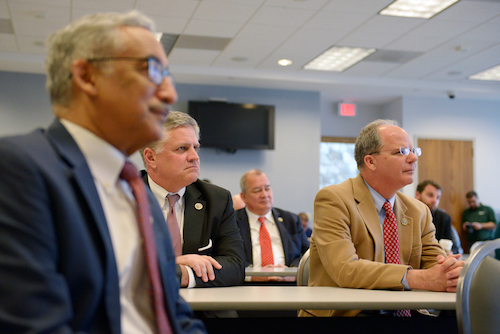Members of the House
Committee on Education and the Workforce
toured a D.C.-area IBEW training
facility, where they received an education of their own about the value of
electrical apprenticeships.

|
| Among the House Committee on Education and the Workforce members on hand for the March event were (from left) Ranking Member Bobby Scott, D.-Va.; Rep. Drew Ferguson, R-Ga.; Del. Gregorio Kilili Camacho Sablan, D-Northern Mariana Islands; and Rep. Brett Guthrie, R-Ky.
|
“Private, union-operated training centers like this one provide the high-quality training that IBEW apprentices need,” said Washington, D.C., Local 26 Business Manager George Hogan, who was hosting the delegation. “The training is paid for through our collective-bargaining agreements, so there is no cost to participants — or to governments.”
In March, Committee Chairperson Virginia Foxx of North Carolina led the bipartisan House delegation’s tour of Local 26’s Joint Apprentice Training Committee center in Lanham, Md., along with fellow Republican Reps. Drew Ferguson of Georgia, Brett Guthrie of Kentucky, and Lloyd Smucker of Pennsylvania.
Representing the committee’s Democratic contingent on the March 13 tour were Ranking Member Bobby Scott of Virginia, Rep. Marcia Fudge of Ohio, Del. Gregorio Kilili Camacho Sablan of the Northern Mariana Islands and New Jersey’s Donald Norcross, who is also an active member of IBEW Local 351 in Folsom, N.J.
The state-of-the-art, 31,000-square-foot Electrical Training Alliance facility is one of three operated by Local 26, a 9,000-member inside local with jurisdiction in the District of Columbia, five counties in Maryland, and 44 counties in Virginia. The local also operates two strategically located satellite training centers.
“Apprenticeships last between three and five years and combine about 800 hours of classroom training with about 8,000 hours of on-the-job experience,” Local 26 Training Director Chris Cash told the members of Congress. “Graduates usually become journeyman wiremen or journeyman linemen and make more than their friends with associate’s degrees, on average.”
Notably, Hogan said, apprentices get paid while they learn, they gain access to full health benefits, and they accrue money toward a defined-benefit pension.
And because the training is completely covered by the partnership between IBEW and its signatory employers in NECA, Hogan added that apprentices don’t leave the program and enter the workforce saddled with thousands of dollars’ worth of college debt.

|
| Washington, D.C., Local 26 Training Director Chris Cash explains to the congressional delegation some of the benefits of a union-operated electrical worker training center.
|
The congressional delegation — accompanied by members of their staff, by JATC personnel and by representatives from the National Electrical Contractors Association — split into two groups to take a closer, firsthand look at some of the facility’s classrooms, equipped to train the local’s more than 1,000 apprentices in areas such as wiring, electronics, fire alarms, motor controls, welding, and pipe-bending.
Asked about the program’s graduation rate, Cash told the representatives that about 60 percent of apprentices successfully complete it. This rate is comparable with figures from the Department of Education’s National Center for Education Statistics, whose latest data says that the 6-year graduation rate for first-time, full-time undergraduate students who began seeking a bachelor’s degree at a 4-year college in 2009 was 59 percent.
Meanwhile, a 2017 study by Public Sector Consultants found that in Michigan from 2000 to 2014, graduation rates for apprenticeships also tended to be higher than those for community colleges. Further, such apprentices earned about $22 an hour after completing union-provided training programs, versus $15 an hour for those who completed non-union programs. Hogan said that those who complete Local 26’s program make about $45 per hour, plus benefits.
Rep. Norcross, the only active IBEW member in Congress, has represented the Garden State’s 1st Congressional District since 2014. He was the first to co-sponsor an IBEW-supported House bill that calls for allowing those who have educational savings plans to use them to pay for apprenticeship training materials such as tools and books.
These tax-sheltered plans, known as 529 plans, typically are offered by states to help families put aside money for college. They derive their name from the section of federal tax law that permits them.
Introduced last summer by Rep. Patrick Meehan (R-Pa.), H.R. 3395 — the 529 Opening Paths to Invest in Our Nation’s Students Act (OPTIONS) Act — has 63 co-sponsors from both parties.